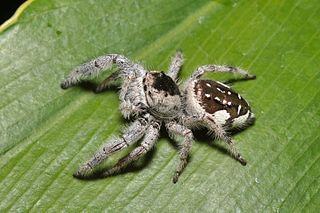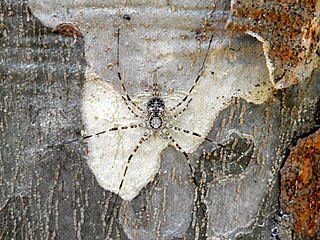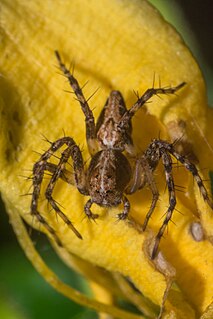
The rockjumpers are medium-sized insectivorous or omnivorous birds in the genus Chaetops, which constitutes the entire family Chaetopidae. The two species, the Cape rockjumper, Chaetops frenatus, and the Drakensberg rockjumper, Chaetops aurantius, are endemic residents of southern Africa. The Cape rockjumper is a resident of the West Cape and south-west East Cape, and the orange-breasted rockjumper is distributed in the Lesotho Highlands and areas surrounding them in South Africa. The two rockjumpers have been treated as separate species but differ in size and plumage. The ranges do not overlap, but come close to doing so.

The Pholcidae are a family of araneomorph spiders. The family contains over 1,800 pholcids, including those commonly known as the marbled cellar spider , daddy long-legs spider, granddaddy long-legs spider, carpenter spider, daddy long-legger, vibrating spider, gyrating spider, long daddy, and skull spider. The family, first described by Carl Ludwig Koch in 1850, is divided into 94 genera.

Paraphidippus aurantius is a species of jumping spider, commonly known as emerald jumping spider. P. aurantius is a solitary hunter, with a fairly large size for a jumping spider. It is black with white side stripes on each side of its head and a white border around the top of the abdomen. It also has a midline of hairs down its center with small white dots and lines on either side.
Pachyballus is a genus of jumping spiders that was first described by Eugène Louis Simon in 1900. While most are found in Africa and nearby regions, one species is endemic to New Caledonia. The name is a combination of the Ancient Greek παχύς ("pachys"), meaning "thick", and the salticid genus Ballus.

Paraphidippus is a genus of jumping spiders that was first described by Frederick Octavius Pickard-Cambridge in 1901. The name is a combination of the Ancient Greek "para" (παρά), meaning "alongside", and the salticid genus Phidippus.

Rugathodes is a genus of comb-footed spiders that was first described by Allan Frost Archer in 1950. It is closely related to members of Theridion and Wamba.

Rugathodes bellicosus is a small theridiid spider that occurs in Europe, including Russia. It is usually found on high ground, but also occurs on coasts. They live under large stones.

The Drakensberg rockjumper or orange-breasted rockjumper is a medium-sized insectivorous passerine bird endemic to the alpine grasslands and rock outcrops of the Drakensberg Mountains of southeastern South Africa and Lesotho. This taxon is closely related to the allopatric Cape rockjumper Chaetops frenatus; the two species of Chaetops are the only living members of the Chaetopidae.

Rugathodes sexpunctatus is a minute species of spider in the family Theridiidae, the cobweb or tangle-web spiders. This family includes the medically important genus Latrodectus—the widow spiders. The species in the genus Rugathodes are too small to be dangerous to humans. Very little is known about most species in this genus.
Hesydrus is a genus of spiders in the family Trechaleidae. It was first described in 1898 by Simon. As of 2017, it contains 7 Central and South American species.

Neotama mexicana, also known as the long-spinneret spider or Mexican two-tailed spider, is a species of tree trunk spider in the family Hersiliidae. It is found in a range from the United States to Peru and Guyana.

Hentzia mitrata, the white-jawed jumping spider, is a species of jumping spider in the family Salticidae. It is found in the United States, Canada, and Bahama Islands.
Habronattus sansoni is a species of jumping spider in the family Salticidae. It is found in the United States and Canada.
Pityohyphantes costatus, the hammock spider, is a species of sheetweb spider in the family Linyphiidae. It is found in the United States.
Xysticus emertoni, or Emerton's crab spider, is a species of crab spider in the family Thomisidae. It is found in the United States, Canada, Slovakia, Russia, and a range from Central Asia to China.

Pirata piraticus is a species of wolf spider in the family Lycosidae. It is found in North America, Europe, Turkey, Caucasus, a range from Russia, Central Asia, China, and Japan.
Habronattus tranquillus is a species of jumping spider in the family Salticidae. It is found in the United States and Mexico.
Phrurotimpus borealis is a species of true spider in the family Phrurolithidae. It is found in North America.

Oxyopes scalaris, the western lynx spider, is a species of lynx spider in the family Oxyopidae. It is found in North America.
Orientattus is a genus of spiders in the jumping spider family Salticidae.












